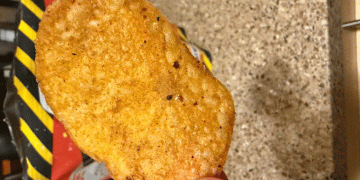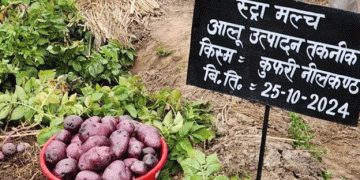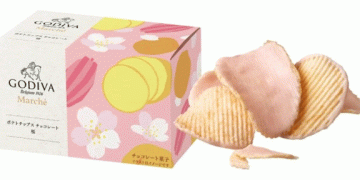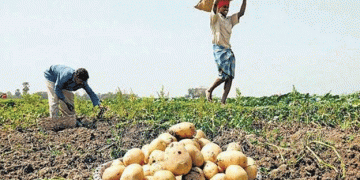When entomologist Andy Jensen visits with potato growers about insects and diseases that can cause significant damage to their crops, he focuses on essential information to help them avoid trouble in the field.
This holds true for potato psyllids and the potentially pocketbook-breaking pathogen that causes zebra chip (ZC), says Jensen, manager of the Northwest Potato Research Consortium, which oversees research grant funding for the Idaho, Oregon and Washington potato commissions.
Potato Psyllids 101
“The potato psyllid is a complex insect,” Jensen says. “They are related to aphids, but psyllids have to lay eggs while aphids give birth to live young.”
The genetic makeup of psyllids also varies, which poses special problems for growers in the Pacific Northwest (PNW).
According to David Horton, research entomologist with the U.S. Department of Agriculture’s Agricultural Research Service (USDA-ARS) in Wapato, Wash., “Most growing regions west of the Mississippi River—where potato psyllids occur—have primarily a single genetic type, but the PNW is unusual because it has three.”
This issue adds to the complexity of psyllid control in the PNW, and it could impact growers elsewhere if the genetic makeup of psyllids continues to evolve and/or psyllids move into new areas.
Identification And Lifecycle
The potato psyllid goes through egg, nymph and adult life stages, all of which are difficult to detect.
The football-shaped eggs are very small and are on a short stalk (when scouting, carry a magnifying glass or 10x hand lens). The eggs are usually on the underside and along the edges of leaves.
Nymphs look like immature soft scales or whiteflies, but unlike scales or whiteflies, they move readily when disturbed.
Adults look like small cicadas, about 0.08 inches long. They are mostly black, but have white markings, and their clear wings rest roof-like over their bodies. When disturbed, they readily jump.
The potato psyllid can complete a generation in less than one month under optimal conditions, according to Pacific Northwest Extension.
To date, scientists have identified four genetically distinct types of potato psyllids in North America, with evidence emerging about variability amongst them in terms of mating and ecology. The importance of these biotypes and whether one or all are relevant to ZC are still not well understood.
What is understood, though, is that ZC continues to threaten potato crops west of the Mississippi River.
Crop Damage
Since the disease first appeared in Idaho, Oregon and Washington potatoes in 2011, some fields surpassed the critical 15 percent ZC incidence level—the threshold for fresh market rejection, says Erik Wenninger, University of Idaho associate professor of entomology.
ZC causes sugars to accumulate throughout the tuber instead of starch. When the potatoes are fried, the lines of sugar turn black, resulting in a black-and-white striped effect and a bitter taste.
Additionally, infested potato plants produce fewer tubers, and yield losses from 20 to 50 percent have been reported.
To spread ZC, potato psyllids must carry the Liberibacter bacterium, which they acquire by feeding on infected plants and through mother to offspring.
Farmers also have to worry about direct feeding damage to potato plants caused by high populations of psyllids, which leads to leaf yellowing and curl—and, in severe cases, death of the plant.
Scouting
Proper identification followed by ongoing scouting is the first step farmers can take to avoid crop devastation.
Of the hundreds of psyllid species that occur in the U.S., Wenninger says, “Only the potato psyllid causes damage to potatoes, so learn how to correctly identify the adults and nymphs.”
Adds Jensen: “Monitoring is critical, and the more the better. Use whatever technique you’re comfortable with, whether yellow sticky traps or some other method (for example, sweep nets or vacuum sampling). When it comes to sticky traps, check and replace them at least once a week, more often if you can.”
Since no action threshold exists for psyllids in potato, the “threshold for action is detection of potato psyllids at any level in any life stage,” according to Potato Psyllid Vector of Zebra Chip Disease in the Pacific Northwest.
And since these critters are constantly on the go, work with neighbors since you can affect your neighbors’ problems and they can affect your problems.
If available, make use of area monitoring programs, including those offered by universities.
Best Management Practices For Controlling Psyllids
An integrated pest management (IPM) program, including the following best management practices, can help control potato psyllids and prevent their spread of ZC:
- Irrigate and fertilize properly to reduce populations of psyllids and other damaging insect pests that feed by sucking the sap produced by plant phloem (the food-conducting tissue of plants) through straw-like mouthparts.
- Protect beneficial insects—ladybugs, lacewings, big-eyed bugs, damsel bugs and minute pirate bugs, among others—and, if possible, provide habitat including flowering plants. According to SCRI Zebra Chip, many of these insects enjoy psyllids for dinner.
- Use insecticides judiciously throughout the growing season as they remain the single best tool to control potato psyllids and help prevent ZC. There are a number of at-plant and foliar insecticides on the market that offer season-long psyllid control and are also beneficial-insect friendly.
- Work with entomologists, Extension educators and other professionals in developing a control plan, and rotate modes of action, in part, to avoid insecticide resistance.
Bayer Solutions
Movento and Sivanto Prime, two insecticides from Bayer, continue to gain reputation among potato growers to control psyllids.
Movento features powerful two-way systemic action that moves within plants to protect them from a broad range of insects and nematodes, above and below the ground, creating highly pest-resistant plants and healthier crops.
Sivanto, meanwhile, precisely targets psyllids and other key pests including aphids.
“Movento has very good residual control, while Sivanto stops damage quickly because it has a rapid and strong feeding cessation effect on psyllids,” says Monte Sorensen, Bayer product manager for insecticides. “They have different modes of action so they fit very well into a rotation-type program to prevent psyllid resistance.”
On top of that, Sorensen underlines: “Both products, when used according to the label, can preserve beneficial insects and nicely fit into IPM plans.”
Movento and Sivanto can follow an at-plant insecticide such as Bayer’s Admire® Pro insecticide.
For more information about these psyllid control options, as well as Oberon® and Leverage® 360 insecticides, please contact your local Bayer representative.
Always read and follow label instructions.






